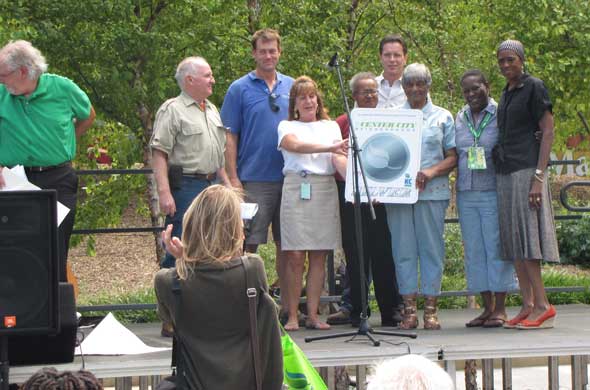
The Center City neighborhood received an award this year for its gardens and orchard, one of the highlights the city recounted in its recap of its “green” programs.
From higher energy standards for city buildings to vast increases in bike lanes and recycling – the city’s progress in “greenness” is all detailed in a new online report.
The 20-page sustainability report lists progress the city has made since it adopted a climate protection plan in 2008.
The major goal of the plan: By 2020, reduce greenhouse gas emissions 30 percent from year 2000 levels.
From the report:
In buildings and operations, the city used $272 million in federal grants to help make major progress.
An automated monitoring system now provides constant information on efficiently operating nine buildings, including city hall.
Since installation three years ago, it has saved up to 30 percent in utility costs. That includes reducing energy use by 14 percent at historic city hall, saving $135,600 a year there alone.
It will soon be used to track and monitor more than 80 solar panels and three wind turbines on the top of city buildings.
Another software program automatically shuts down about 4,000 city computers during non-business hours, saving about $80,000 a year.
In 2011, the city started requiring LEED gold construction standards for new city projects, including affordable housing.
The city saves $130,000 a year since converting traffic signal lights to LEDs and a pilot project is underway to convert streetlights to LEDs.
The city runs an alternative fuel fleet of more than 345 vehicles that run on natural gas, propane or electricity.
Vast wastewater management and recycling efforts are also underway.
Listed as among the worse cities for biking and walking in 2008, the city now has 29 miles of bike lanes, nine miles of sharrows and 63 miles of trails.
In land use, the city’s brownfield program has helped clean up 109 sites totaling 163 acres.
The new Land Bank program this year is putting foreclosed houses and blighted lots back into private use.
The city is working to encourage healthy eating and urban agriculture and has changed zoning laws to do it.
It also is working to support building a food hub, where local growers could sell to large buyers like schools and hospitals.
This year, for the first time, city staffers started the Green Neighborhood Recognition Program for neighborhoods that did an outstanding job on green issues.



Who’s talking